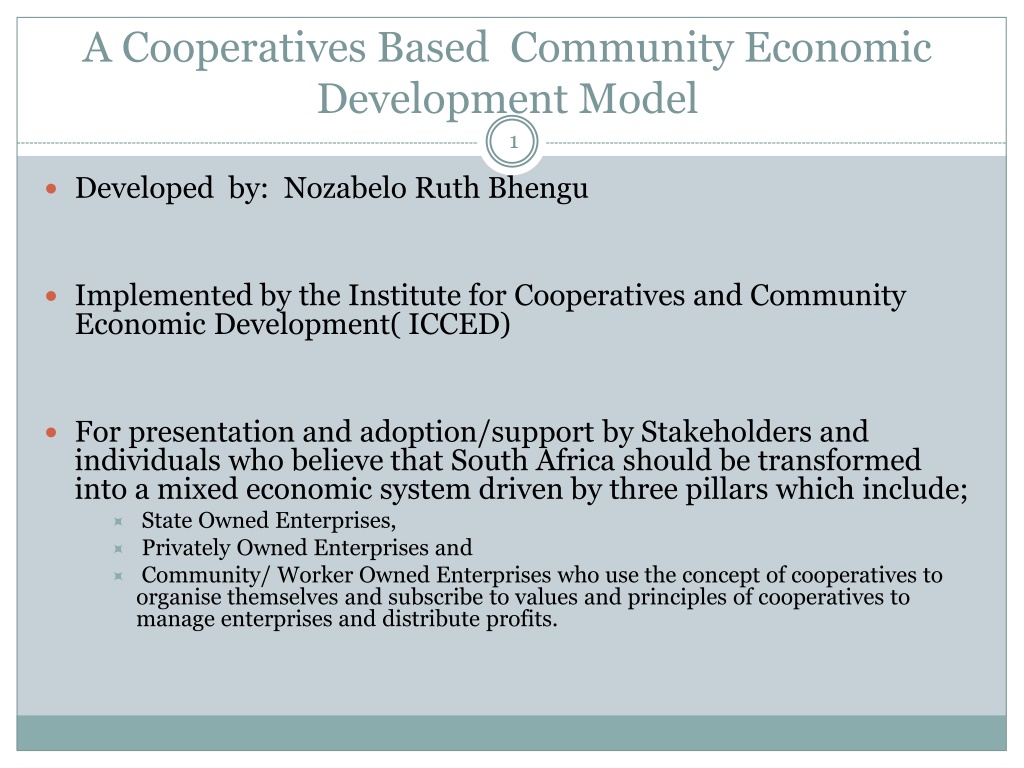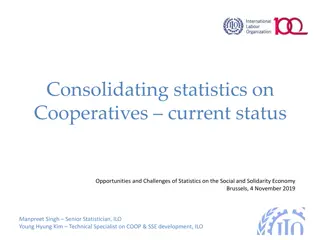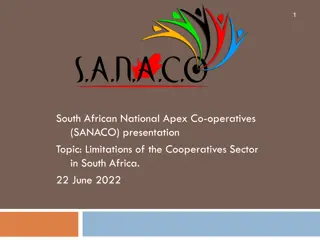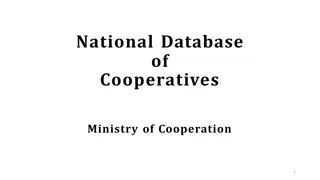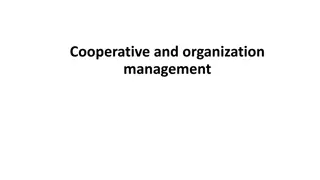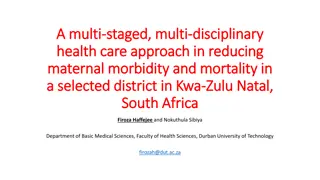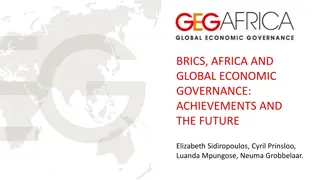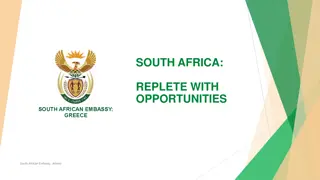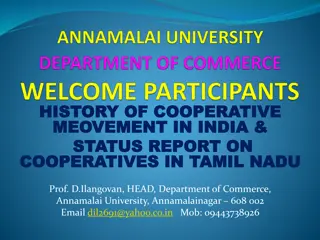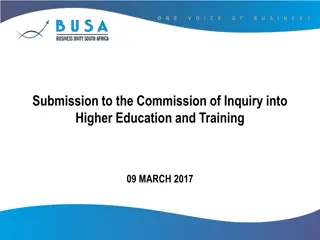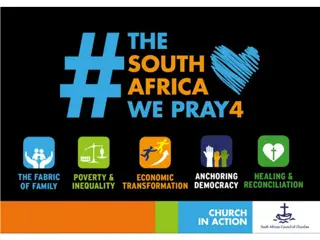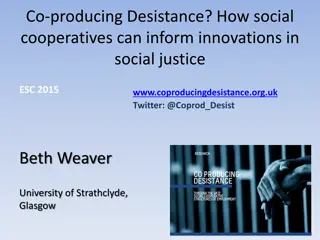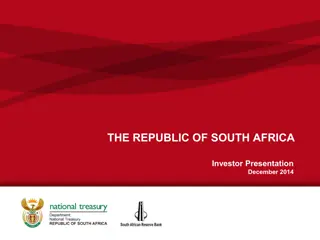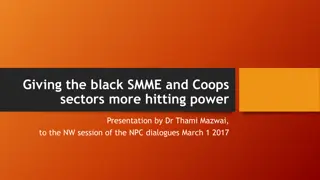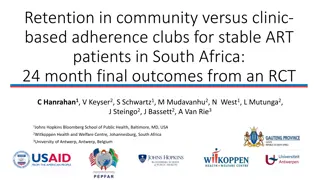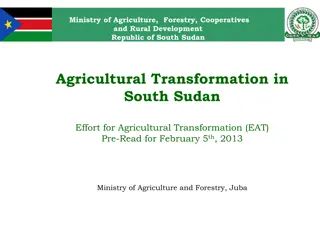Cooperatives-Based Community Economic Development Model in South Africa
The Cooperatives-Based Community Economic Development Model aims to transform South Africa into a mixed economic system driven by state-owned, privately-owned, and community/worker-owned enterprises organized as cooperatives. It seeks to reduce exploitation, promote justice and democracy in the economy, and align with government policies to alleviate poverty and uplift communities.
Download Presentation

Please find below an Image/Link to download the presentation.
The content on the website is provided AS IS for your information and personal use only. It may not be sold, licensed, or shared on other websites without obtaining consent from the author. Download presentation by click this link. If you encounter any issues during the download, it is possible that the publisher has removed the file from their server.
E N D
Presentation Transcript
A Cooperatives Based Community Economic Development Model 1 Developed by: Nozabelo Ruth Bhengu Implemented by the Institute for Cooperatives and Community Economic Development( ICCED) For presentation and adoption/support by Stakeholders and individuals who believe that South Africa should be transformed into a mixed economic system driven by three pillars which include; State Owned Enterprises, Privately Owned Enterprises and Community/ Worker Owned Enterprises who use the concept of cooperatives to organise themselves and subscribe to values and principles of cooperatives to manage enterprises and distribute profits.
Purpose of the presentation to the Portfolio Committee 2 To enable the Portfolio Committee to relook at the Cooperatives Based Community Economic Development Model again having been to Mondragon, to see whether the model has elements of Mondragon and also relates to South African conditions. To give an opportunity to DSBD to also look at the model and decide to support or reject it. To afford both the Portfolio Committee and DSBD an opportunity to understand ICCED and how ICCED is implementing the model. The model is supported in principle by three international bodies of International Training Institute. cooperatives and one
What does the Cooperatives Based Community Economic Development Model mean to RSA 3 It is a politically informed intervention in the economy aimed at reducing exploitation of communities and workers by capitalists. It is informed by resolutions of ANC conferences, the 1969 held in Morogoro and 2012 held in. Mangaung. South Africa cannot be allowed to have a welfaristic state for the poor dependant on government handouts on one hand and a developmental state for a few filthy rich capitalists. Professor Ben Turok has written about this situation in his book Wealth Doesn t Trickle Down The Case for a Developmental State in South Africa. President Kwame Nkrumah also wrote about the phase we are at in South Africa in his book - Race and Class Struggle in Africa. The Cooperatives Based Community Economic Development Model is about justice and democracy in the economy.
Relevance of the model to South African conditions 4 It is based on existing government policies and intervention programmes on poverty. It facilitates strategic alignment of government policies located in different departments. It has a potential to create permanent exit of poor families from social grant and indigent registers of municipalities thereby increasing revenue base of municipalities. A child born in an RDP house would not grow up to join the queue of RDP beneficiaries or mobilise communities to protest and demand more free services from government
5 It is based on cooperatives found in a particular area preferable at a ward level or a specific sector. Thathane Cooperatives are 17 cooperatives in ward 10 of Ubuhlebezwe Municipality all involved in agriculture. King Grange and King of Midlands are at sector level, the taxi industry . It is also based on existing assets at community level including; natural resources such the sun, wind, trees; human resources; under utilised facilities found in communities such abandoned and dilapidated buildings which could be renovated; churches with land and unused buildings; closed down schools; properties belonging to government.
Direct investment to communities and knoweldge transfer 6 Attracts investment directly to communities and facilitates partnership between innovators and communities. These include; Moladi Construction Systems in housing, EGGS Technology Systems of Clean Air Nurseries in agriculture, FORUS Block chain in digital exchange There are many other strategic partners with technologies which can be used by communities for their own development. Merantz Technology SA
International support to build capacity in South Africa 7 Attracts support from international cooperatives movements training institutions and NGO . ICCED is already getting support from; Mondragon Consulting Business in Spain- Management of cooperatives type of enterprises. Coady International Institute in Canada Training of trainers on Asset Based Community Development Model. DGRV Cooperatives an Apex body in Germany Auditing of cooperatives (the VBS situation would not have happened) JICA an NGO in Japan Knowledge transfer from Japan to other countries. Lantimannen Cooperatives in Sweden Twining.
Relevance of the model to government policies and the need for alignment to such policies 8 NDP goals and active participation of citizens in their own development. All sectors. 2012 to 2030. Transformation of South Africa into a mixed economic system ANC in 1969 and in 2012 conferences. Provision of RDP houses to the poor Department of Human Settlement and municipalities where RDP houses are built. One hectare One Household - Department of Rural Development and Land Reform. Renewable Energy Mix - Department of Energy. 30 % procurement of goods and services from SMMEs and Cooperatives- All departments Economic transformation to build South Africa into a mixed economic system- DSBD mandate on cooperatives development. Creation of 9.9 new jobs by 2030 through SMMEs and Cooperatives- DSBD mandate Carbon Emission reduction targets Department of Environmental Affairs
Key features of the model 9 Existing cooperatives are organised to work together. Feasibility study and development of a Master Plan for a particular area (a ward or village or a farm). Cooperatives and Skills Development Centre establishment at community level to develop skills required to develop economy of the area. Strategic partnership private sector or another cooperative (Thathane EWS Schoenau Cooperative in Germany) facilitated by ICCED and DGRV. 20 % investment by private sector with technologies needed by communities with option for cooperatives to buy out investment partners when loans are paid off. 80% ownership by cooperatives. Profit distribution 50% to members, 30% towards Cooperative Bank to finance further development 20% towards Cooperatives and Skills Development Centre at community level.
Comparisons between Mondragon and South Africa 10 Mondragon South Africa 1892 the 1st cooperative, a consumer cooperative was established. 1909 railway workers formed the Salt River Trading Consumer Cooperative. Before 1930, the rules and restrictions against black population held back development of cooperatives although black organisations had started to promote cooperatives and several trading cooperatives, land banks, building and burial societies were established. In 1941 the priest arrives in an isolated poor underdeveloped Mondragon community with high rate of unemployment and resolved to change that situation. In 1943 he organised the community to develop itself. In 19 52 a technical college is established in Mondragon . In 1956, 5 engineers produced by the technical college are assigned by the priest to set up the first worker- member owned factory to produce paraffin stove and heater.
11 South Africa Mondragon No dependence on government. Mondragon established before Basque government. Basque government and Spanish government learns from Mondragon. White owned cooperatives supported by government. In 1969 the ANC resolves to transform South Africa into a mixed economic system. 1994 the ANC assumes power and mandates the Department of Social Development to develop cooperatives, later DTI to 2014. ANC government adopts a narrow approach not relating to transformation of South Africa into a mixed economic system.
Comparisons between Mondragon and South Africa 12 South Africa Mondragon In 2009 DTI report on cooperatives indicate d that there was 88 % failure rate out of more than 22000 registered cooperatives. Mondragon expands to international level through Mondragon International Investment and Management Consultig Business. 2014 DSBD established and mandated to develop SMMEs and Cooperatives big confusion as DSBD fails to make a distinction between SMMEs and Cooperatives , advocates for same support services for SMMEs and Cooperatives. Fails to implement provisions of the Cooperatives Development Act.
Comparisons between Mondragon and South Africa 13 South Africa Mondragon Central to development of the Mondragon cooperatives are the following: Humanity at work- community organising. Knowledge through training focusing on the concept of cooperatives and technical skills needed to develop the economy. Industry Production factories. Finance- Cooperative Bank Research, innovation and technology- Cooperative university. Retail. Management Consulting Business at international level. Central to development of cooperatives are the following: The Cooperatives Incentive Scheme. Training limited to compliance, financial management, conflict resolution and seven principles of cooperatives. Establishment of the Cooperatives Development Agency. Establishment of the Cooperatives Training Academy. Establishment of Cooperatives Tribunal. Establishment of Cooperatives Banks Development Agency
Comparisons between Mondragon and South Africa 14 South Africa Mondragon The Mondragon model is a community driven development approach informed by isolation then of the Mondragon community in Basque region and their need to survive on their own socially and economical under the dictatorship of Francisco Franco who ruled Spain from 1939 until his death in 1975. The ICCED model is a community driven development approach which seeks to implement a ruling party resolution to transform South Africa into a mixed economic system thereby facilitating active ownership of the economy by communities who were excluded by the colonial and apartheid systems in South Africa and to introduce democratic values and principles in enterprises management and distribution of profits to further develop the community as a whole.
Comparisons between Mondragon and South Africa 15 South Africa Mondragon The model was developed and pioneered by a priest with no political involvement. The model was developed and is pioneered by a politician with a community development background and is implemented by an NGO, ICCED. The starting point is the establishment of a community development and technical skills training centre in Merrivale and alignment of government policies to development of cooperatives. The starting point was the establishment of a technical skills training centre which produced 5 engineers.
Comparisons between Mondragon and South Africa 16 South Africa Mondragon ICCED model has a strong community development perspective however, ICCED is working against a top down government driven and grant based approach which will need to be addressed moving forward. Strong community development perspective 100% driven by community using its own resources. ICCED model is solidarity, long-term self- reliant oriented. Mondragon is Solidarity , long- term and self-reliant oriented. The aim is to transform the South African economy into a mixed economic system a resolution taken by the ANC before it even assumed power. The model therefore is aimed at changing the mind set and instill this understanding at government, private sector and community level hence the establishment of ICCED to provide training aimed at creating that understanding and facilitating establishment of community and worker owned enterprises subscribing to values and principles of cooperatives. No need for government involvement, grew and survived without government interference. Both national and provincial government were prepared to learn from Mondragon community.
Comparisons between Mondragon and South Africa 17 South Africa Mondragon Cooperation cooperatives structures cooperatives with no government interference. Basque Government learning from Mondragon. When we asked Mondragon support they government they said to spread the gospel about Mondragon and make the whole of Spain know about Mondragon model and implement it. between Cooperation cooperatives and cooperatives development controlled by government DGRV and EU funding is channeled through DSBD, Land Bank and SEFA development of cooperatives to government red tape. South Africa needs a model that helps government to achieve its objective of transforming the structure, control and ownership of the economy to include the social economy. between development determined by structures is what from subjecting need
Comparisons between Mondragon and South Africa 18 SouthAfrica Mondragon ICCED s model adopts the same pillars as used by Mondragon, and adapts the Mondragon model to suit South African conditions by including alignment of existing government policies and programmes to the process of developing cooperatives and position them as a tool for facilitating establishment of community owned enterprises resulting in sustainable communities and transformation of South Africa into a mixed economic system Clear focus in terms pillars which drive the Mondragon model: Knowledge Finance Industry Retail Research and innovation International Consulting Business.
Proposed support from DSBD to implement the model 19 Adopt the model and partner with ICCED to implement it. Establish a dedicated team of young people in DSBD to undergo training on ICCED Model and Mondragon Model and deploy them to work with ICCED to implement the model. Support the relationship between ICCED, Mondragon, DGRV, Coady and Lantmannen and JICA. That will assist to attract direct investment to communities, international donor funding to ICCED to build internal capacity and for implementation of the model in different communities, including loan funding for community projects, e.g EU funding. Fund the research and policy development aspect of the model which will be done by Mapungubwe Institute for Strategic Reflections. Fund Feasibility studies and Master Plan development of pilot projects. Fund establishment of Cooperatives and Skills Development Centre at community level.
Proposed support from DSBD to implement the model 20 Fund exchange programmes / Study Tours for pilot projects and municipalities where pilot projects are located to Mondragon and DGRV in Germany. Fund Training of Trainers to be provided by Coady in Partnership with ICCED. Establish a Skills Levy for Cooperatives Development- Have accreditation and funding for training provided by Cooperatives Training Academy. Unlock start up funding for ICCED and other similar initiatives by supporting the model as a possible solution. Strengthen cooperative movement and facilitate establishment of Apex Body. Develop policies and support services which seek to facilitate establishment of community owned enterprises and worker owned enterprises. Monitor progress made and evaluate impact on poverty reduction and establishment of sustainable communities. If no measurable development impact is made through pilot projects in 10 years from 2019 to 2029, discontinue government support and abolish the Cooperatives Based Community Economic Development model in South. Africa.
21 Establish the Cooperatives Development Agency before 2019 elections as a dedicated agency for development of cooperatives , community owned enterprises and worker owned enterprises. Establish the Cooperatives Training Academy to accredit training institutions providing training to cooperatives and to also provide funding for promotion of social economy. Forge partnership with SETA to facilitate access to training funding for ICCED. Follow up on Mondragon to show interest and facilitate access to funding for Mondragon to provide consulting services to ICCED and pilot projects. Follow up on DGRV initiative with ICCED on renewable energy mix as a strategic intervention to reduce costs of doing business by community owned enterprises as well as making indigent households self- sufficient and self reliant. Establish all support structure for cooperatives as per provisions Cooperatives Development Act.
Conclusion 22 It took 10 years to develop the model from 2006 to 2016. It was improved after every consultative session with a number of people and organisations. It has blind spots like all other strategic interventions, however it reached a point where it was worth implementing improvement as we move forward. and addressing areas of The Department of Human Settlement and the Department of Rural Development have shown interest and identified five pilot project for establishment of sustainable communities by aligning development of Housing Cooperatives ( RDP houses) to One household One Hectare programme of DRDLR. Every journey starts with one step, let us take that one step.
